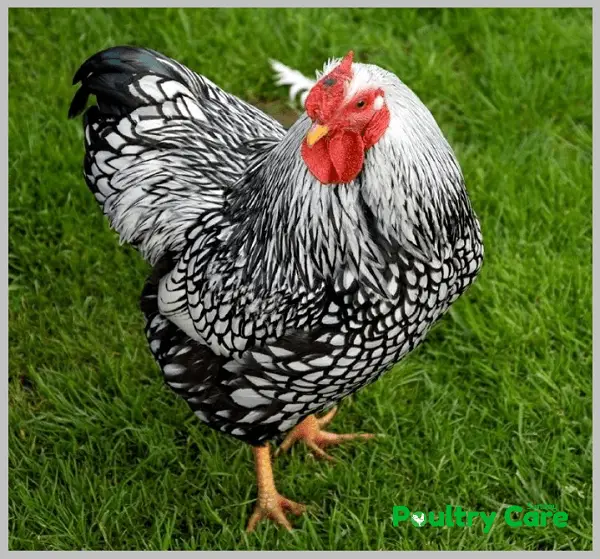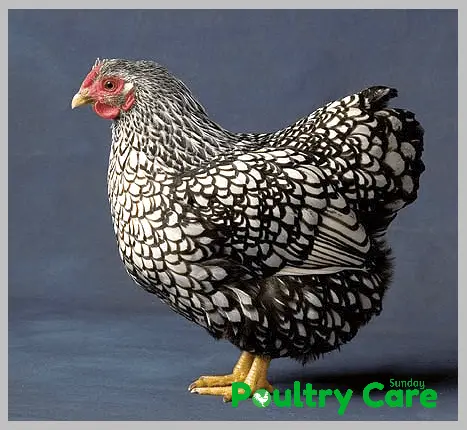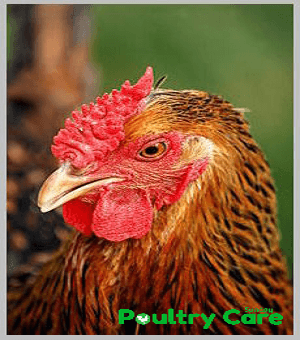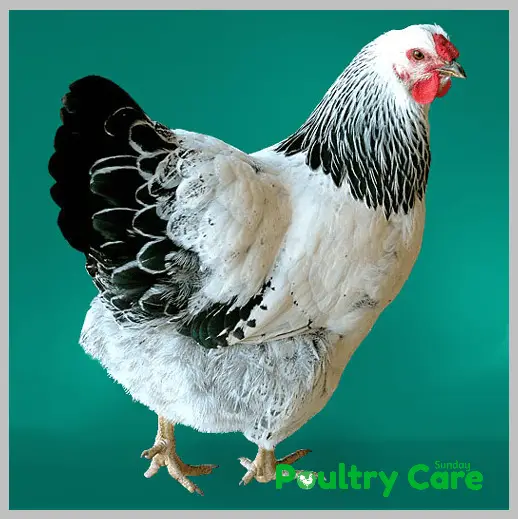The Wyandotte fowl originates from Ontario in Canada and also around upstate New York. They used to be called the American Sebright but this name was changed to the Wyandotte Chickens from a Native American tribe who lived in these areas with their long and interesting history.
There are still a few members of this tribe who still live in Northern Oklahoma and the logo for the Silver Wyandotte Club of America features a drawing of the Indian tepee.
The first ever Wyandotte was a Silver laced Wyandotte which was bred in Wisconsin in the USA.
Related Article – 15 Most Common Chicken Diseases, Symptoms and Treatment
Characteristics Of The Wyandotte
Body
In the American Poultry Association ‘Standard of Perfection’, the Wyandotte fowl is described as a ‘curvy’ bird, but well balanced. This means its legs are set squarely under the center of the bird’s body.
The Wyandotte carries its body in a horizontal-type position on its stout and yellow shanks. If you look at this bird from the front view, you will note that its legs are well-spread and quite heavily boned.
The shank of the bird is medium in length and you can see its full hock. The hock (if you don’t know) is the joint situated between the shank and drumstick on the bird.
Basically, it is the “ankle”-joint of a bird. The Wyandotte breast is wide and full, although the back is of a medium length.
A standard Wyandotte cock will weigh in at about 8½ pounds, the cockerel at about 7½ pounds, a hen will weigh in at about 6½ pounds and a pullet will weigh in at about 5½ pounds.

Black Laced Silver Wyandotte Chicken
Head
An interesting characteristic of a Wyandotte is its skull which has good breadth; actually a broader skull in comparison to other American class breeds.
It has a bold look to its head with its crowning feature being is rose comb. The typical rose comb of the Wyandotte is low and it is tight to its head.
This follows down the head, ending at the back of its head to a neat spike. It has a short neck which is well curved with plenty of hackle feathers.
The hackle is well-rounded in order to carry out an unbroken line of both neck and head.
Back and Tail
The back reveals what looks like a short space just above the Wyandotte’s shoulders. This is level and then rises to the tail, blending in smoothly and evenly.
There isn’t a break where the back levels off and where the tail starts. This is the reason why some people think that the Wyandotte’s have shorter backs.
But it’s not the case. The breadth of the Wyandotte’s back gets carried out in the broadness of the body.
So when you see the sideline of the bird looking down on the bird, everything appears smooth with no indentations.
Wings
The Wyandotte’s wings are held level and they are not too long. The wings are snugly folded and held in place.
It has a short well-spread tail at the base. The male’s sickle feathers are of medium-length, curving well over the end of its main tail feathers.
The top of the tail is level with the head and neck junction, lining up with the earlobes.
Feathers
Feathers of the Wyandotte’s are a bit softer and looser than the other chicken breeds in the American class.
Origins Of The Plumage Of The Wyandotte
The Silver Laced Wyandotte chicken variety was the original Wyandotte, but its origins still are a bit unsure. There are some who suggest that the Dark Brahma which was used than produced the early crosses.

Silver Laced Wyandotte Chicken
Others talk about a breed called Chittagong with a view varieties in it. The Plumage of the Chittagong was bits of yellow and brown.
Some earlier chicken writers claim that the Brahma blood brought about the creation of the Chittagong.
Other writers agree that there was another breed that created the Wyandotte as well and that it was the Silver Sebright (this is not the bantam fowl with the same name).
This breed of Wyandotte seems to have had the laced plumage-pattern. There doesn’t seem to be any proof of the origin of the Silver Sebright’s origin except that it was imported.
A few thoughts seem to go around as to its actual origin, but the most popular and accepted idea was the Polish, the Breda and the Silver Hamburg (Mooneys) which were varieties in the creation of the Silver Sebright.
Types of Wyandotte Chickens
There are different types of Wyandotte chickens and some are ultra rare such as:
- Black Copper Marans
- Blue Easter Egger
- Blue Favaucana
- Cream Legbar
- Lavender Orpington
- Olive Eggers
- Partridge Olive Egger
- Snowy Easter Egger
- Super Blue Egg Layer
- BBS Ameraucana
- Blue Copper Marans
- Blue Orpington
- Blue Splash Marans
- Buff Chantecler
- Double Laced Barnevelder
- Frost White Legbar
The Colors And Variations Of an Earthy Rainbow
With Wyandotte Chickens, you will find about 17 different colors; the most well-known ones being the Golden Laced Wyandotte chicken, the silver penciled, blue-laced, buff, Laender, partridge, pure white and black.
So What Are the Variations?
Silver Laced Wyandotte: The silver laced Wyandotte have beautiful white feathers, each feather edged in black, called “lacing”. This variety has a black tail and the bird legs should have yellow.
Blue Laced Red Wyandotte: It has a buff-red color with a blueish-grey color around the edges of all the feathers
Golden Laced Wyandotte: It is a beautiful golden color with black edges around every feather and also a black tail, A Golden laced Wyandotte chicken speaks for itself. Golden Laced Wyandotte chickens are a favorite amongst backyard chicken owners.
White: White all over. The rarest color in the Wyandotte.
Black: Pure black all over.

Golden Laced Wyandotte Chicken
Buff: Buff all over (gingery-orange color).
Buff Laced: Buff-colored but have white around the edges of the feathers.
Partridge: Beautiful reddish color. It has three black stripes that meet in the middle of the feather, going outwards. The cock is the typical-looking story-book farmyard type cock.
Columbian: This fowl is white and also has a black tail with black wing tips and a black neck, although some white can be seen.

Columbian Wyandotte Chicken
Red: Dark reddish/brown all over.
Mille Fleur: Dark brown with black crescents. White spots on the tip.
Barred: Black and whites strip across the feather width, seen all over the body.
Buff Columbian: Like the Columbian above, except buff-colored.
Silver Penciled: Like with the Partridge Wyandotte, but the hen has a silver under-color while the cock color is white with the bit of black until you reach the tail and wings color is black.
Blue: All over the blue in the hen and black for the cock but for blue wings and tail which are blue.
In the USA, 9 beautiful colors of Wyandotte chickens are recognized by the American Poultry Association, in their Standard of Perfection.
There are no rules in naming any new breeds in the USA, but generally, most breeds are named from the locality from whence they come.
So, for instance you will find Rhode Island Reds or New Hampshire and other names.
30 Colors are listed in Europe and in Great Britain they list their Wyandotte colors as barred, blue, black, blue-laced, buff, blue partridge, buff, buff-laced, Gold laced, Columbian, partridge, silver-laced, red, white and silver-penciled.
There are also new color variations of Wyandotte chickens that are being created still by breeders from all over the world and one of the newest colors is the “Chocolate Partridge”.
Why People Love Getting Wyandotte Chickens:
The Plusses:
The minuses:
Where Do You Find The Wyandottes?
Other Interesting Bits About The Wyandotte Birds:
Protecting our Wyandottes!
It is very important that the Wyandottes don’t disappear – become extinct. That is why they have become known as amongst others, a Heritage Breed. Check out this top – Chicken Feeder and Waterer Plans for your chicken.
The American Livestock Breeds aim is to secure “heritage” into the agricultural marketplace. Heritage chickens are noted to:
Final Verdict
The aim is for long-term conservation, to recover the breeds to the early cultural and culinary treasures known in the past – we can’t let go of the Wyandottes.
Those same chickens that our grandparents of old used to allow to compost the grass before settling into their straw nests to lay their eggs.
Need to come back into our modern times – in our backyards and our farms – certainly, something to crow about.
DON’T MISS
Last Updated on January 14, 2025 by Pauline G. Carter

